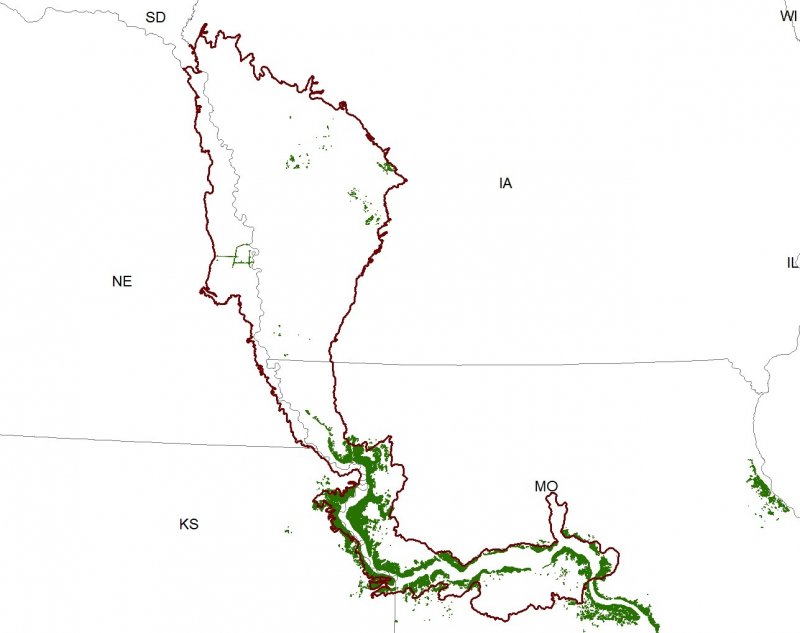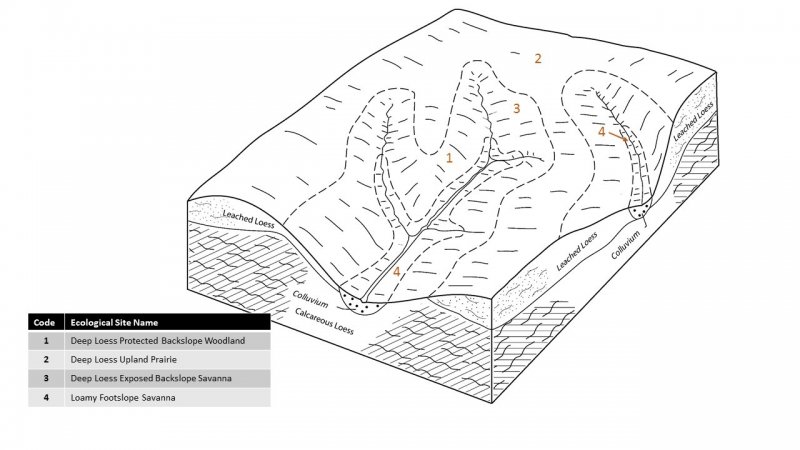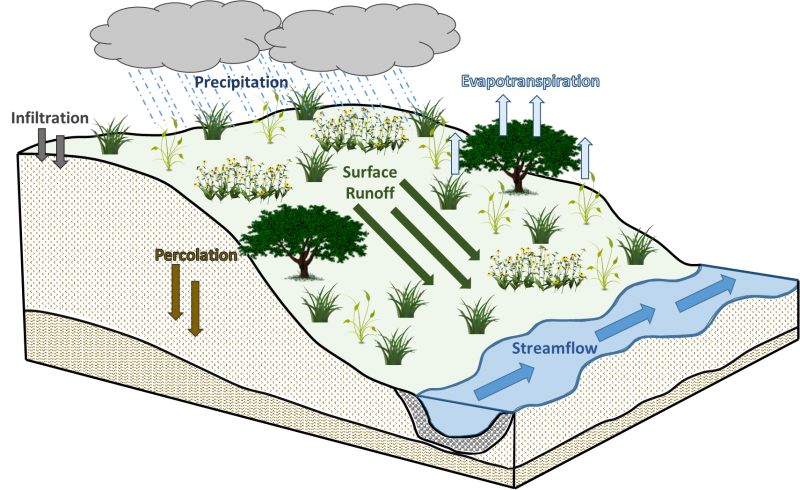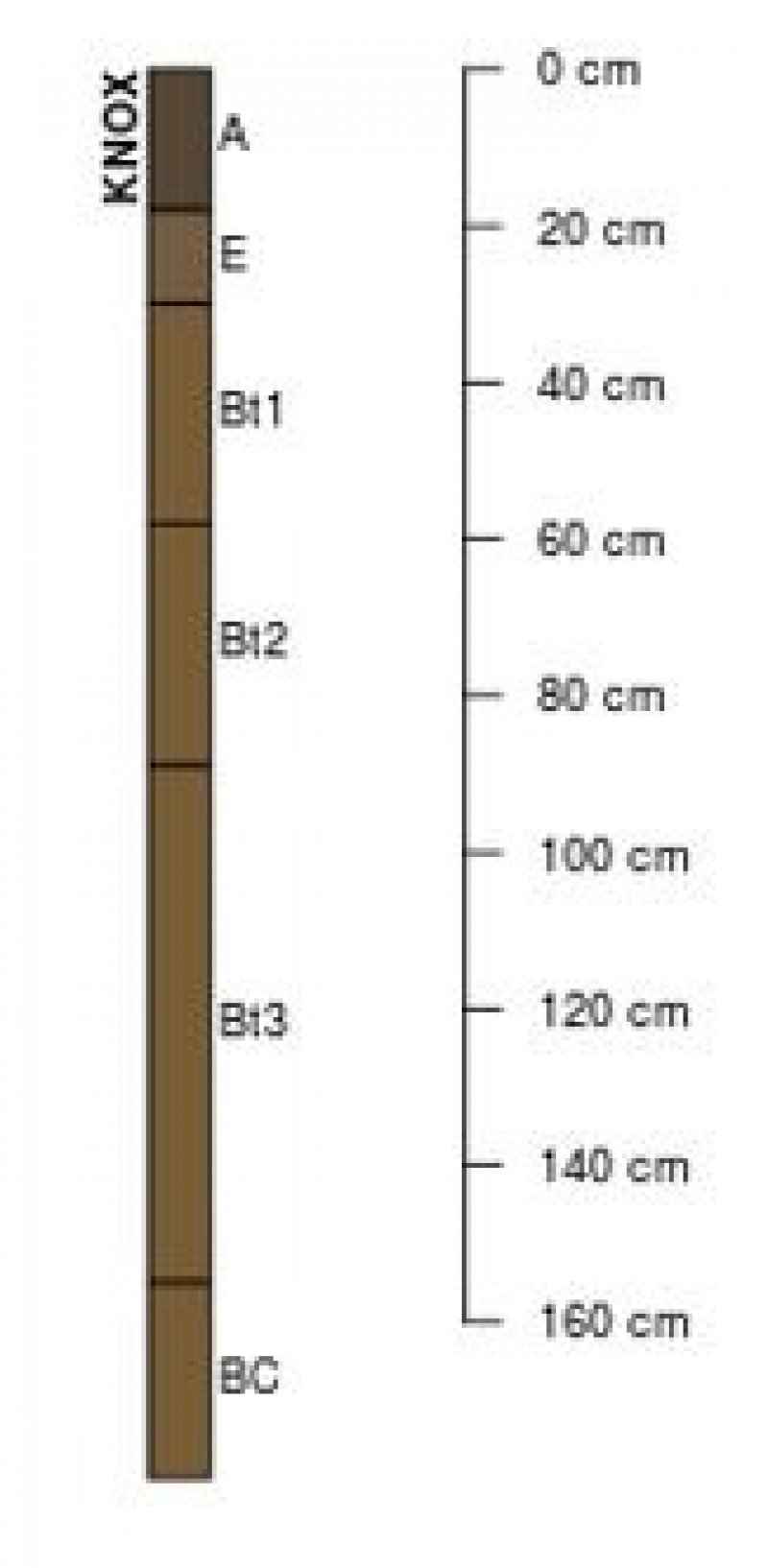
Natural Resources
Conservation Service
Ecological site F107XB004MO
Deep Loess Protected Backslope Woodland
Last updated: 5/21/2020
Accessed: 12/21/2025
General information
Provisional. A provisional ecological site description has undergone quality control and quality assurance review. It contains a working state and transition model and enough information to identify the ecological site.
Figure 1. Mapped extent
Areas shown in blue indicate the maximum mapped extent of this ecological site. Other ecological sites likely occur within the highlighted areas. It is also possible for this ecological site to occur outside of highlighted areas if detailed soil survey has not been completed or recently updated.
MLRA notes
Major Land Resource Area (MLRA): 107X–Iowa and Missouri Deep Loess Hills
The Iowa and Missouri Deep Loess Hills (MLRA 107B) includes the Missouri Alluvial Plain, Loess Hills, Southern Iowa Drift Plain, and Central Dissected Till Plains landform regions (Prior 1991; Nigh and Schroeder 2002). It spans four states (Iowa, 53 percent; Missouri, 32 percent; Nebraska, 12 percent; and Kansas 3 percent), encompassing over 14,000 square miles (Figure 1). The elevation ranges from approximately 1,565 feet above sea level (ASL) on the highest ridges to about 600 feet ASL along the Missouri River near Glasgow in central Missouri. Local relief varies from 10 to 20 feet in the major river floodplains, to 50 to 100 feet in the dissected uplands, and loess bluffs of 200 to 300 feet along the Missouri River. Loess deposits cover most of the area, with deposits reaching a thickness of 65 to 200 feet in the Loess Hills and grading to about 20 feet in the eastern extent of the region. Pre-Illinoian till, deposited more than 500,000 years ago, lies beneath the loess and has experienced extensive erosion and dissection. Pennsylvanian and Cretaceous bedrock, comprised of shale, mudstones, and sandstones, lie beneath the glacial material (USDA-NRCS 2006).
The vegetation in the MLRA has undergone drastic changes over time. Spruce forests dominated the landscape 30,000 to 21,500 years ago. As the last glacial maximum peaked 21,500 to 16,000 years ago, they were replaced with open tundras and parklands. The end of the Pleistocene Epoch saw a warming climate that initially prompted the return of spruce forests, but as the warming continued, spruce trees were replaced by deciduous trees (Baker et al. 1990). Not until approximately 9,000 years ago did the vegetation transition to prairies as climatic conditions continued to warm and subsequently dry. Between 4,000 and 3,000 years ago, oak savannas began intermingling within the prairie landscape, while the more wooded and forested areas maintained a foothold in sheltered areas. This prairie-forest transition ecosystem formed the dominant landscapes until the arrival of European settlers (Baker et al. 1992).
Classification relationships
Major Land Resource Area (MLRA): Iowa and Missouri Deep Loess Hills (107B) (USDA-NRCS 2006)
USFS Subregions: Central Dissected Till Plains Section (251C); Deep Loess Hills (251Ca), Loess Hills (251Cb) Subsection; Nebraska Rolling Hills Section (251H), Yankton Hills and Valleys (251Ha), Pawnee City-Seneca Rolling Hill (251Hd) (Cleland et al. 2007)
U.S. EPA Level IV Ecoregion: Steeply Rolling Loess Prairies (47e), Rolling Loess Prairies (47f), Nebraska/Kansas Loess Hills (47h) (USEPA 2013)
Biophysical Setting (LANDFIRE 2009): North-Central Interior Maple-Basswood Forest (4213140)
Ecological Systems (National Vegetation Classification System, Nature Serve 2015): North-Central Interior Maple-Basswood Forest (CES202.696)
Eilers and Roosa (1994): Upland Woods
Iowa Department of Natural Resources (INAI nd): Central Mesic Forest
Lauver et al. (1999): Acer saccharum – [Acer nigrum] – Tilia americana – Quercus rubra/Ostrya virginana Forest
Missouri Natural Heritage Program (Nelson 2010): Mesic Loess/Glacial Till Forest
Nebraska Game and Parks Commission (Steinauer and Rolfsmeier 2010): Red Oak – Basswood – Ironwood Forest
Plant Associations (National Vegetation Classification System, Nature Serve 2015): Acer saccharum – Acer nigrum – Tilia americana – Quercus rubra/Ostrya virginana Forest (CEGL002061)
Ecological site concept
Deep Loess Protected Backslope Woodlands are mapped in complex with Deep Loess Exposed Backslope Savannas and are located within the green areas on the map (Figure 1). They occur on north- and east-facing backslopes with slopes greater than fifteen percent. Soils are Alfisols, Entisols, Inceptisols, and Mollisols that are well-drained and very deep, formed from loess. These fine-silty, fertile soils have high soil uniformity resulting in increased nutrient- and water-holding capacity, increased organic matter retention, and good soil aeration that allows deep penetration by plant roots, which generally results in high plant productivity (Catt 2001). These sites occur adjacent to Deep Loess Upland Prairies and Deep Loess Exposed Backslope Savanna ecological sites.
The historic pre-European settlement vegetation on this site was dominated by northern red oak (Quercus rubra L.) and American basswood (Tilia americana L.). Other tree species can include bitternut hickory (Carya cordiformis (Wangenh.) K. Koch), shagbark hickory (Carya ovata (Mill.) K. Koch), and white oak (Quercus alba L.), and sugar maple (Acer saccharum Marshall) becomes an important component on the eastern side of the Missouri River. The shrub layer is typically populated with pawpaw (Asimina triloba (L.) Dunal) and slippery elm (Ulmus rubra Muhl.). Herbaceous species typical of an undisturbed plant community associated with this ecological site include narrowleaf wild leek (Allium burdickii (Hanes) A.G. Jones), American spikenard (Aralia racemosa L.), blue cohosh (Caulophyllum thalictroides (L.) Michx.), and American ginseng (Panax quinquefolius L.) (Ladd and Thomas 2015; Steinauer and Rolfsmeier 2010; Nelson 2010). Historically, catastrophic windthrow was the primary disturbance factor that maintained the composition of this site, while extreme drought, periodic pest outbreaks, browsing by native ungulates, and infrequent fires can limit woody species survival and recruitment (LANDFIRE 2009; Nelson 2010; Gucker 2011).
Compared to calcareous loess wooded ecological sites in the MLRA, Deep Loess Protected Backslope Woodlands have no soil carbonates. The resulting lower pH environment slows the mineralization of nitrogen as well as leaves other important nutrients (phosphorus, iron, manganese) more available for plant uptake making these sites slightly more productive than their calcareous counterparts (Larcher 2003). In addition, Deep Loess Protected Backslope Woodlands have a higher clay content which increases the water holding capacity.
Associated sites
| F107XB009MO |
Calcareous Loess Upland Woodland Calcareous loess soils on slopes less than 15 percent including Pohocco and Timula |
|---|---|
| F107XB011MO |
Calcareous Loess Exposed Backslope Woodland Calcareous loess soils on slopes greater than 15 percent with south and west aspects, including Pohocco and Timula |
| R107XB002MO |
Deep Loess Upland Prairie Leached soils on slopes less than 15 percent including Arents, Contrary, Deroin, Higginsville, Melia, Monona, Ponca, Sibley, Sibleyville, Strahan, Udarents, Udorthents, Wakenda |
Similar sites
| R107XB003MO |
Deep Loess Exposed Backslope Savanna Deep Loess Exposed Backslope Savannas only occur on south and west aspects |
|---|---|
| F107XB009MO |
Calcareous Loess Upland Woodland Calcareous Loess Upland Woodlands have calcareous soils and only occur on slopes less than fifteen percent and are bur oak dominated |
| F107XB011MO |
Calcareous Loess Exposed Backslope Woodland Calcareous Loess Exposed Backslope Woodlands have calcareous soils and only occur on south- and west aspects and are bur oak dominated |
| F107XB010MO |
Calcareous Loess Protected Backslope Forest Calcareous Loess Protected Backslope Forests are similar in landscape position but are bur oak dominated and soils are calcareous |
Table 1. Dominant plant species
| Tree |
(1) Quercus rubra |
|---|---|
| Shrub |
(1) Asimina triloba |
| Herbaceous |
(1) Carex jamesii |
Click on box and path labels to scroll to the respective text.




